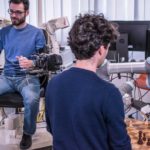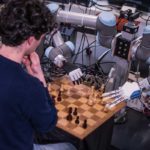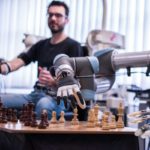The Sant’Anna team
The Sant’Anna team will be based on the expertise in robotics of the Scuola Superiore Sant’Anna, that according to the THE university ranking is the first university in Italy. Sant’Anna has a long outstanding tradition in robotics, from biorobotics to advanced robotic applications.
The Sant’Anna team will develop a semi-humanoid Avatar endowed with advanced manipulation capabilities and enabling remote multimodal interaction. It will make use of two dexterous arms and hands, and of a full upper limbs exoskeleton interface to allow intuitive teleoperation with enriched and precise haptic feedback. The proposed system, called Sully, has been specifically designed to meet the requirements of the competition based on existing collaborative robot arms and custom design parts, i..e mobility platform, robot hands, robot trunk and body, robot head.
The Sant’Anna team is coordinated by two research areas of the TeCIP and Biorobotics Institute and is composed of professors and researchers of Scuola Sant’Anna and of a group of more than 15 undergraduated talented students of Engineering of Scuola Sant’Anna from different courses, Aerospace, Mechanical, Robotics, Electronics, Bionics and Computer Science.
The Human-Robot Interaction area
The Sant’Anna team will be led by Prof. Antonio Frisoli and coordinated via the Human-Robot Interaction (HRI) area of the Perceptual Robotics Laboratory. The PERCRO laboratory has a long tradition in telepresence, simultaneous presence and virtual presence.
Since 1993 the laboratory started to work in the area of remote touch and exoskeletons for Virtual Reality applications. The HRI area covers all aspects ranging from mechanical design, advanced control and experimental testing of robots cooperating and interacting with humans, with special emphasis on wearable robotic systems – i.e. robot exoskeletons that can be worn on human body -, haptic interfaces and advanced telepresence systems, hereby including semi-autonomous robotic platforms that can be used to transport human senses in remote environment.
Due to this intensive research, in 1993 from HRI area stemmed out one spin-off company, the Wearable Robotics srl (www.wearable-robotics.com), that commercializes the Alex exoskeleton, a dual upper limb exoskeleton for neurological rehabilitation and that is already a patented medical device. The Wearable Robotics srl is listed among the key-players in the rehabilitation market and in the wearable robotics technologies.
The Artificial Hands Area
The BioRobotics Institute will participate in the research activities via the Artificial Hands Area (AHA).
The AHA conducts research into mechatronics and human-machine interfaces for advanced artificial limbs to be used as thought-controlled prostheses and robotic end-effectors, building on the pioneering work developed at the ARTS lab of Scuola Superiore Sant’Anna (SSSA) in the early 90s. Current research topics include robotic hands and dexterous grasping, upper-limb prosthetics including partial hand prostheses, non-invasive human machine interfaces for the physiological control of prehension, robust artificial tactile sensors and wearable sensory feedback devices.
The Area is involved in consortia dealing with cognitive robotics, human-robot interaction and neuro-controlled prosthetics. On these topics the AHA coordinated/participated in more than 17 national/international research projects in the past decade. In December 2018 the laboratory was sponsored for a three-year research project (total budget secured of 3.7 M€) from the company INPECO SA, working in the field of Laboratory Automation.
In the research of the AHA special emphasis is placed in the development of reliable and effective devices that can be used outside of the laboratory and exploited commercially. This attitude, combined with the EC project SMARTHAND, allowed to spin out in 2009 Prensilia which is a start-up company of SSSA that develops and commercialised robotic hands for research and industry. Today, 30 labs around the world deploy hands or biomimetic fingers originally developed by the AHA.






